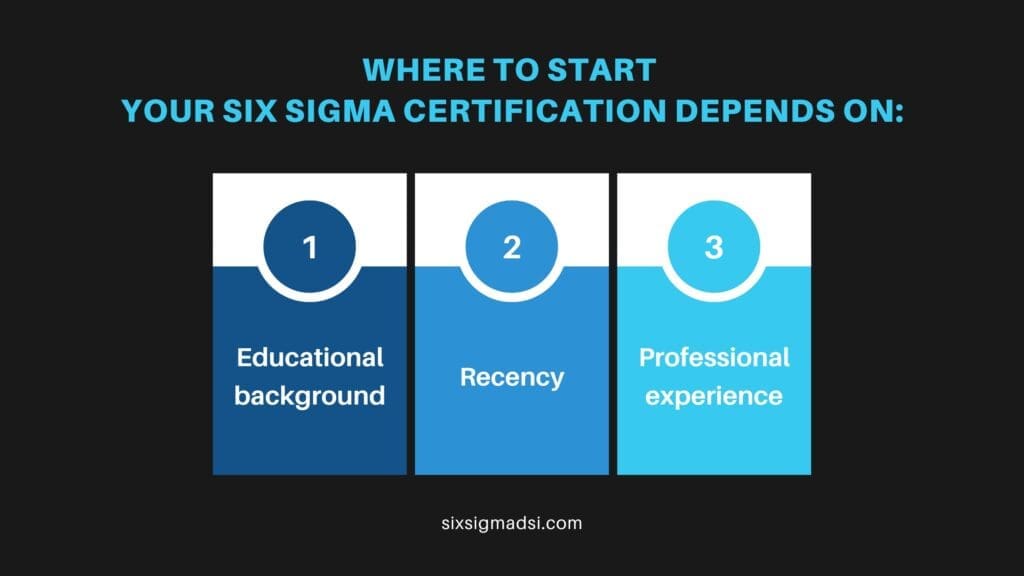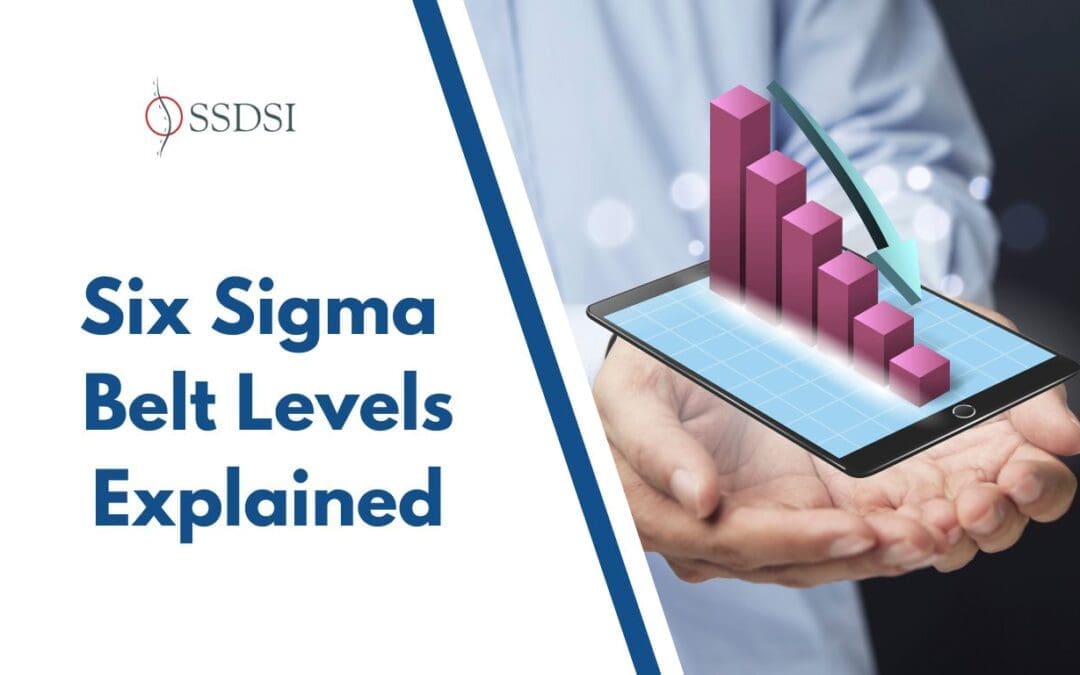Six Sigma certification serves as a validation of an individual’s proficiency in applying Six Sigma methodologies. Certification pathways are typically pursued through structured training programs offered either online or onsite by various organizations.
These programs culminate in certification at different levels, denoted by belt colours, indicating increasing levels of expertise and responsibilities within Six Sigma projects.
Table of contents
Detailed Breakdown of Six Sigma Belt Levels
| Certification Level | Description | Typical Job Titles | Average Salary |
| Six Sigma White Belt | Introductory level; basic understanding of Six Sigma concepts without formal certification. Participates in local problem-solving teams, contributing to quality management and waste reduction efforts. | Transition Project Managers, Change Management Specialists, Integration Project Managers, Performance Test Leads | Not specified |
| Six Sigma Yellow Belt | Basic understanding beyond White Belt; attends short training sessions. Can contribute to projects, assist higher belt levels, and review process improvements. | Data Governance Analysts, Commissioning Engineers, Laboratory Operations Managers, Solutions Architects | $85,200 |
| Six Sigma Green Belt | Requires full certification course; leads projects applies DMAIC methodology for process improvement and uses statistical tools like control charts and FMEA. Prepares individuals for roles managing quality and process improvement. | Quality Engineers, Continuous Improvement Managers, Production Supervisors, Quality Managers | $95,600 |
| Six Sigma Black Belt | Advanced certification following Green Belt; leads complex projects, mentors Green Belts, and drives organization-wide improvements. In-depth understanding of LSS strategies and statistical analysis. | Industrial Production Managers, General and Operations Managers, Management Analysts, Project Management Specialists | $120,200 |
What are the belt levels in Lean Six Sigma?

Six Sigma Champion
A Champion is the first level of Six Sigma certification. Although a Champion is not a belt per se, it plays a crucial role in Six Sigma projects and organizations. The primary function of the Champion is to ensure that all operational projects align with strategic business objectives.
Six Sigma White Belt Certification
This entry-level certification provides a foundational understanding of Six Sigma concepts and terminology. White Belts learn process improvement methods. It contributes to a culture of continuous improvement, though they are usually not on project teams directly.
Six Sigma Yellow Belt Certification
The Yellow Belt for Six Sigma is the place to learn about the belt level, its principles, applications to work, and how to best use your time. Yellow Belt professionals are well-versed in all phases of Lean Six Sigma.
Yellow Belts builds upon White Belt knowledge with a deeper dive into Six Sigma methodologies. These include DMAIC (Define, Measure, Analyze, Improve, Control). They learn basic data collection techniques, and quality tools like Pareto charts and histograms, and gain an understanding of how Six Sigma principles apply to their specific roles within project teams.
Six Sigma Green Belt Certification
Positioned between Yellow Belts and Black Belts, Green Belts are capable of leading Six Sigma projects under the guidance of Black Belts or independently on smaller-scale initiatives.
They undergo extensive training. It consists of five to ten days of classroom instruction, depending on the organization and industry focus. Green Belt training covers project management, advanced statistical analysis, quality management tools, and problem-solving techniques.
Green Belts are change agents within their organizations, focusing part-time on process improvement while managing their regular job responsibilities. They lead project teams, conduct data analysis, and contribute significantly to achieving project goals aligned with organizational objectives.
A Six Sigma Green Belt assists a Black Belt in analyzing and solving quality issues and participating in quality improvement initiatives.
Green Belts can also help to review data and provide suggestions for lower-tiered belts. Sometimes, Green Belts have the experience and knowledge to manage their projects. It all depends on how experienced they are in the field. The workhorses of any business are the Green Belts.
Six Sigma Green Belt holders are employed as:
- Compliance structural engineers
- Lead manufacturer engineers
- Operating system specialists
- Business process analysts
- Senior IT project managers
Six Sigma Black Belt Certification
Black Belts are Six Sigma experts who lead complex projects from inception to completion. They possess advanced knowledge in statistical analysis, project management, and process optimization. Black Belts undergo intensive training ranging from three to six weeks, tailored to their industry—shorter durations for service or transaction-based industries and longer programs for manufacturing or research and development environments.
Candidates for Black Belt certification often have backgrounds in technical fields with a strong foundation in mathematics and quantitative analysis. While formal training in statistical methods is beneficial, it’s not always a prerequisite as Black Belts receive comprehensive instruction in statistical tools during their certification process.
Black Belts are crucial in driving significant improvements within their organizations, collaborating closely with leadership to identify strategic projects, mentor Green Belts, and ensure sustainable outcomes through the effective implementation of Six Sigma methodologies.
Six Sigma Black Belts are typically employed in the following positions: Project Manager, Vice-President of Operations, and Manager of Manufacturing.
Six Sigma Master Black Belt
At the pinnacle of Six Sigma expertise, Master Black Belts provides strategic leadership and technical guidance across the entire Six Sigma program. They are seasoned professionals selected from experienced Black Belts based on their comprehensive understanding of statistical methods, advanced project management skills, and ability to coach and mentor others effectively.
Individuals must have at least five years of experience as a Six Sigma Master Black Belt (MBB), or at least 10 BBSS projects during their professional career. You must submit these documents to be approved for a portfolio review. The ASQ and IASSC review your Six Sigma experience, including coaching and teaching, mentoring, and your responsibilities as a BBSS professional. They also evaluate your innovation and technical knowledge.
Six Sigma Black Belts are typically employed in senior project management, senior process engineer, lean transformation expert, and similar roles. Master Black Belts are the leaders in the food chain for Lean Six Sigma/Black Belt Six Sigma subject matter specialists [in the field].
Master Black Belts play a pivotal role in shaping the organization’s Six Sigma strategy. This aligns initiatives with business objectives, and drives continuous improvement at an enterprise level. They oversee multiple projects simultaneously. Also, they offer insights into complex statistical analyses and ensure the integrity and consistency of Six Sigma practices throughout the organization.
Also Read: What Is a Lean Six Sigma Certification?
Where to Start Depends on Three Factors

Educational background
The Yellow Belt certification is ideal for humanities disciplines like English, Art, Music, and Journalism as a starting point. This credential focuses on conceptual aspects similar to Lean Belt principles, covering ‘where,’ ‘when,’ ‘why,’ and ‘how.’ It applies these concepts with statistical data, which is central to the Green Belt and beyond. Enrolling in the Yellow Belt course provides an excellent foundational entry into this subject matter.
The Green Belt certification is for liberal arts graduates with backgrounds in social sciences, economics, and natural sciences. Their exposure to mathematical and statistical frameworks makes it easier for them to grasp the core statistical concepts covered by the Green Belt.
A prerequisite for transitioning directly to the Green Belt involves a robust comprehension of Statistics and Mathematics. Engineers with a strong quantitative aptitude generally find the Green Belt curriculum manageable. Some may even consider pursuing the Black Belt, particularly those who excel in statistics.
Individuals with a business education should consider directly pursuing the Green Belt certification. While Marketing and Management majors might opt to commence their journey with the Yellow Belt, the choice primarily hinges on their comfort level with statistical concepts.
Recency
The competencies gained during academic tenure remain relevant, especially for individuals who have been away from formal education for fewer than five years. This duration typically allows for the retention of the capacity to comprehend abstract and quantitative concepts.
Hence, if the hiatus from academia spans less than five years, it should not impede the capacity to engage with educational material. The educational entry point depends more on academic background than on how long one has been away from formal learning.
Individuals who have been detached from formal education for five years or more should consider recalibrating their starting point within the educational program. Those possessing suitable foundational knowledge might find suitability in pursuing the Yellow Belt or Green Belt certifications as alternate starting points within the curriculum.
Professional experience
Individuals who are profound in Lean and Quality management and have a strong grasp of statistical concepts and quantitative reasoning should pursue the Black Belt certification. They should also demonstrate sustained engagement in formal learning or have accumulated significant experiential knowledge in relevant domains.
However, individuals transitioning careers often encounter a hiatus from formal education and may lack familiarity with current systems or methodologies. We recommend starting with the Yellow Belt for those comfortable with statistical principles, gradually acclimating before potentially advancing to the Green Belt. Engaging in the Black Belt curriculum without adequate preparation might pose considerable challenges, leading to frustration and potential discouragement.
Final Words
Certification at each level typically involves passing examinations that assess both theoretical knowledge and practical application of Six Sigma principles. Higher levels of certification require candidates to demonstrate a deeper understanding and application of statistical tools, project management skills, and strategic thinking, leading to variations in exam complexity and duration.

About Six Sigma Development Solutions, Inc.
Six Sigma Development Solutions, Inc. offers onsite, public, and virtual Lean Six Sigma certification training. We are an Accredited Training Organization by the IASSC (International Association of Six Sigma Certification). We offer Lean Six Sigma Green Belt, Black Belt, and Yellow Belt, as well as LEAN certifications.
Book a Call and Let us know how we can help meet your training needs.












